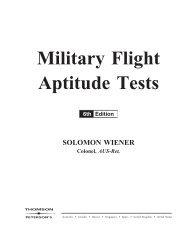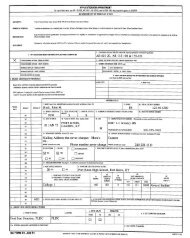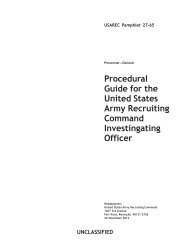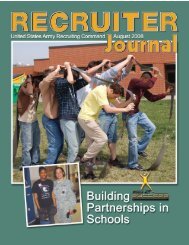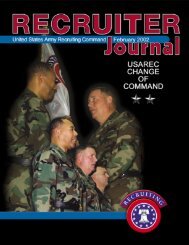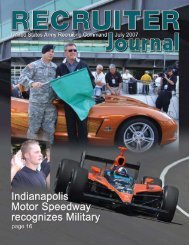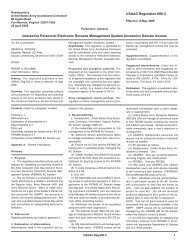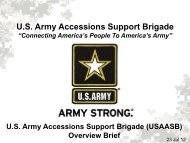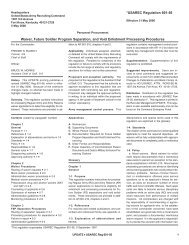June RJ 09 - USAREC - U.S. Army
June RJ 09 - USAREC - U.S. Army
June RJ 09 - USAREC - U.S. Army
You also want an ePaper? Increase the reach of your titles
YUMPU automatically turns print PDFs into web optimized ePapers that Google loves.
Transformation<br />
“Our transformation is an evolving process with the goal<br />
of aligning our functions with those of the <strong>Army</strong> modular<br />
force,” said Deputy Commanding General Brig. Gen. Joseph<br />
Anderson. “We want <strong>USAREC</strong> to resemble an operational<br />
division and our brigades to resemble brigade combat<br />
teams.”<br />
Several staff sections and functions are being realigned<br />
this month in the headquarters, to include a synchronization<br />
of communications functions between the G5, G7/9 and the<br />
CIG, and the movement of the Enlistment Standards Division,<br />
the investigative arm of the commander, from G3 to an<br />
independent staff section under the Deputy Commanding<br />
General, according to Rick Ayer, director of the Commander’s<br />
Initiative Group.<br />
To better link training and operational functions, the<br />
Training Assessment Division is being moved into the G3 to<br />
manage training and assessment, annual training and<br />
command training guidance, and the long range calendar.<br />
The Recruiting and Retention School will still manage<br />
doctrine, central recruiting courses and personnel<br />
proponency.<br />
Previously part of the SMB, the Cyber Recruiting<br />
Division will move to the G3 and the Outsourcing Division<br />
will become part of the G4/8.<br />
The Command is also creating a Future Operations<br />
Division, or FUOPS, in the G3 to integrate future planning,<br />
contingency operations and tasking, and developing a<br />
Headquarters Battlestaff that is designed to synchronize the<br />
staff efforts to more effectively execute daily tasks.<br />
“Most of these changes should be fairly invisible to the<br />
recruiter,” Ayer said. “This realignment is going to allow the<br />
<strong>USAREC</strong> headquarters and brigade headquarters to be more<br />
responsive and supportive of the field’s needs and to do a<br />
better job planning for where we are heading and removing<br />
some of the mystery of future plans for the field.”<br />
Earlier this year, the command reviewed all the battalion<br />
and brigade realignments and identified that the one piece<br />
that wasn’t working well was the centralization of administrative,<br />
budget and logistics functions at the Special<br />
Mission Brigade (SMB) Recruiting Support Center (RSC).<br />
8 | RECRUITER JOURNAL | JUNE 20<strong>09</strong><br />
Headquarters Realigning Staff Functions,<br />
Changing Role of Special Missions Brigade<br />
By Julia Bobick, Editor<br />
Recruiting Command is well into its next phase of transformation:<br />
a realignment of headquarters staff functions to improve support<br />
to the field force as well as a review of the centralization of brigade<br />
administrative, budget and logistics functions at the headquarters.<br />
Based on that, the command asked Booz Allen<br />
Hamilton to conduct an independent assessment of the<br />
RSC. Their assessment also concluded that current<br />
structural alignment did not support the functions. As a<br />
result, Maj. Gen. Thomas Bostick approved in early May<br />
the restructuring of the SMB, the return of some functions<br />
to the brigade staffs and an augmentation of the<br />
<strong>USAREC</strong> staff.<br />
“This is not about a failure of the SMB or that the<br />
individuals in SMB weren’t doing their jobs; the added<br />
layer was just the wrong structural alignment for the<br />
command,” Ayer said. “What we are doing is moving<br />
forward to a new transformation model. Only certain<br />
functions are being looked at to move back to the<br />
brigade.”<br />
Some of the functions consolidated at the RSC are<br />
very effective, Ayer said. The command will keep those<br />
efficiencies, but centralize them at the headquarters level<br />
instead of the Special Missions Brigade.<br />
“There will still be a Special Missions Brigade; we<br />
don’t want to dissolve the brigade because we think<br />
there’s a future role for that brigade,” Ayer added. The<br />
brigade will retain the warrant officer, chaplain and<br />
special operations recruiting missions, and potentially<br />
assume some other roles this coming year. <strong>USAREC</strong> has<br />
also approached Accessions Command about taking on<br />
the ROTC recruiting mission for Cadet Command.<br />
Transformation working group Process Action Teams<br />
(PATs), which include brigade representation, are<br />
working to determine the appropriate structure, functions<br />
and positions that will be reintegrated into the brigade<br />
staffs.<br />
Anderson conducted a town hall meeting with the<br />
SMB staff May 7 to inform them of the decision. Close to<br />
100 civilian employees at the headquarters will be<br />
affected by the transformation.<br />
“One of our primary missions is taking care of people;<br />
we are committed taking care of each and every individual<br />
impacted by this realignment,” Anderson said<br />
during the meeting.



